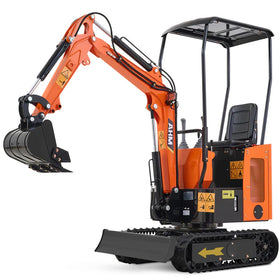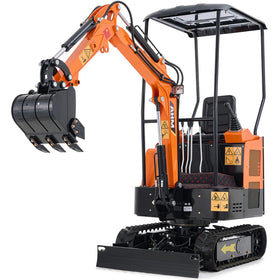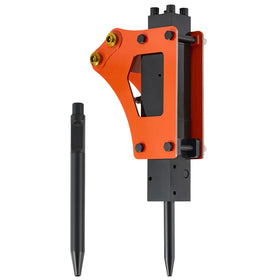Installing a lawn irrigation system is one of the smartest investments you can make for your property, but here's the thing: the traditional installation process is a nightmare. We're talking about days of backbreaking trenching, lawn damage, and labor costs that'll make your wallet weep.
But what if we told you there's a way to install a lawn irrigation system that cuts your trenching time by 70%, reduces labor costs by up to 60%, and gives you precision that hand-digging simply can't match? The secret weapon? A mini excavator.
Whether you're a DIY homeowner tackling your first irrigation project or a contractor looking to streamline your process, using a mini excavator to install a lawn irrigation system changes everything. Let's dig into why this approach is revolutionizing how smart property owners handle irrigation installation.

What Makes A Good Lawn Irrigation System?
The best lawn irrigation systems deliver consistent water coverage, reduce waste, and operate automatically to keep your landscape thriving. Modern automatic sprinkler systems cost between $2,533 - $5,118 for the average quarter-acre yard, with installation accounting for roughly 50% of the total project cost.
But here's where most homeowners hit a wall: installation. Traditional irrigation system installation involves extensive trenching that can take 8-16 hours for underground systems. Crews typically dig trenches 6 inches wide and about 12 inches deep to fit all the pipe, which means significant disruption to your existing lawn.
The real problem? Most DIY installations fail because of three critical issues:
- Inadequate trenching depth - Hand-digging rarely achieves the consistent depth required for proper pipe installation
- Uneven trench width - Variable widths lead to poor pipe protection and settling issues
- Massive time investment - DIY installations require 8-16 hours for in-ground systems compared to 2-4 hours for above-ground alternatives
This is exactly where using a mini excavator to install your lawn irrigation system becomes a game-changer.

How to Install a Lawn Irrigation System
Installing a lawn irrigation system requires careful planning, precise execution, and the right equipment. Here's the step-by-step process:
Step #1. Planning and Design
Before you break ground, you need a solid plan. Most manufacturers offer custom-design services specific to your yard and region, typically requiring at least 30-35 psi of water pressure and 10-13 gpm of water flow to support a sprinkler system.
Key planning elements include zone mapping, sprinkler head placement for complete coverage, water pressure calculations, and permit requirements that cost $50-$400, depending on location.
Step #2. Trenching Challenges
The trenching phase is where most irrigation installations go wrong. Hand-digging trenches take 10-12 hours for 100 feet, while machines reduce this to 2-3 hours.
Standard requirements include 6-12 inches depth, 4-6 inches width for pipe protection, proper grading for drainage, and consistent depth to prevent low spots that collect water.
Step #3. Installation Process
Once trenching is complete, installation involves pipe layout and connection, sprinkler head positioning at ground level, control system setup with 24-volt wiring, and backflow prevention devices costing $250-$550 plus installation.
The reality? This traditional process is labor-intensive, time-consuming, and prone to errors that can cost thousands to fix later.
How to Install a Lawn Irrigation System with a Mini Excavator
Using a mini excavator to install an irrigation system for a lawn is far easier than you think. With the mini excavator and the suitable mini excavator attachments, digging is a lot easier and quicker. Follow these steps:
Step #1: Site Preparation and Marking
Mark your irrigation layout, call 811 to identify underground utilities, and position your mini excavator at the starting point.
Step #2: Precision Trenching
Set depth control for consistent 8-12 inch trenches, dig main water line trenches first, and create branch trenches for individual zones. Mini excavator trenchers can dig at speeds up to 100 feet per hour, depending on soil conditions.
Step #3: Pipe Installation and Backfilling
Install PVC pipes and fittings, connect sprinkler heads and zone valves, test water flow before backfilling, and use the excavator's bucket for efficient backfilling and grading.
Advantages of Using a Mini Excavator to Install a Lawn Irrigation System
The advantages of installing your diy lawn irrigation system with a mini excavator go far beyond just speed:
1. It Is Time Efficient
- Using a mini excavator can result in a 70% reduction in trenching time. You can complete most residential irrigation trenching projects in 4-6 hours instead of 2-3 days
- Single-day installation. You can install the entire system in one day
- No weather disturbances. Quick installation reduces weather-related delays
2. It Saves Cost
Professional irrigation installation costs $50-$100 per hour, with labor accounting for 50% of total costs. Mini excavator trenching cuts labor hours by 60-70%. Mini excavator rental costs $200-$700 per day versus multiple days of manual labor.
3. The Installation Quality is Superior
- The depth control is consistent. The hydraulic precision of a mini excavator ensures proper pipe depth
- There is better compaction with a mini excavator. Clean trenches reduce settling issues
- The risk of pipe damage is greatly reduced with a mini excavator. Controlled excavation prevents accidents
- The results are always professional-grade. Even DIY installations achieve contractor-level quality
4. Environmental and Property Benefits
Mini excavators produce less noise and have a reduced environmental impact. Additional benefits include minimal lawn damage, reduced soil compaction, better drainage protection, and increased property value.
Best Mini Excavators to Install a Lawn Irrigation System
Choosing the right mini excavator for your irrigation installation makes all the difference, and AHM’s awesome lineup has got you covered:
1. AHM AX-12
Starting at $6,799.99, the AX-12 is perfect for homeowners tackling their first irrigation installation.
Why the AX-12 excels for irrigation installation:
- 73-inch maximum digging depth - 12% deeper than comparable models, perfect for 8-12 inch burial depth
- 3'1" total width - Fits through standard garden gates
- 2,227 lb operating weight - Light enough to prevent lawn damage while providing stability
- 13.5 HP Briggs & Stratton engine - Consistent power for all-day trenching
The AX-12's 123.2-inch maximum digging radius lets you trench extensive layouts without constantly repositioning.
Perfect for: Quarter-acre to half-acre properties, first-time irrigation installers, budget-conscious homeowners.

2. AHM AX-16
Starting at $8,999.99, the AX-16 delivers professional-grade performance for serious irrigation work.
Why contractors choose the AX-16:
- 23 HP dual-cylinder engine - 70% more power for faster trenching through tough soil
- 71-inch maximum digging depth - Handles deep irrigation main lines and complex systems
- 3,262 lb digging force - Powers through clay and compacted soil
- 3'3" width with a reduced tail swing - Maneuvers in tight residential spaces
The AX-16's 1000mm wide dozer blade adjusts from 16cm to +16cm, making backfilling incredibly efficient.
Perfect for: Professional installers, large residential properties, commercial irrigation projects
3. AHM AX-15: The Kubota-Powered Precision Machine
Starting at $9,499.99, the AX-15 features a premium Kubota diesel engine for extended operation and superior reliability.
Why the AX-15 stands out:
- 13.8 HP Kubota D722 engine - Runs quieter with 3x longer engine life
- EPA Tier 4 compliance - Meets the strictest emissions standards
- Enhanced combustion system - 50% lower particulate matter for neighbor-friendly operation
- 69-inch maximum digging depth - Ideal for standard residential systems
Perfect for: Noise-sensitive areas, environmentally conscious homeowners, contractors prioritizing long-term reliability
The Bottom Line
Installing a lawn irrigation system doesn't have to be a weeks-long ordeal that destroys your yard and drains your wallet. When you install a lawn irrigation system with a mini excavator, you're choosing efficiency, precision, and professional results.
A properly installed irrigation system using a mini excavator pays for itself through reduced water bills, increased property value, and eliminated manual watering time. So, stop wrestling with hoses and dealing with brown spots.
Start planning your irrigation installation with the right equipment, and discover how much easier lawn care becomes when you do lawn irrigation system repair the smart way.
Check out the guidelines for more mini-excavator projects, like digging a trench with a mini excavator.







